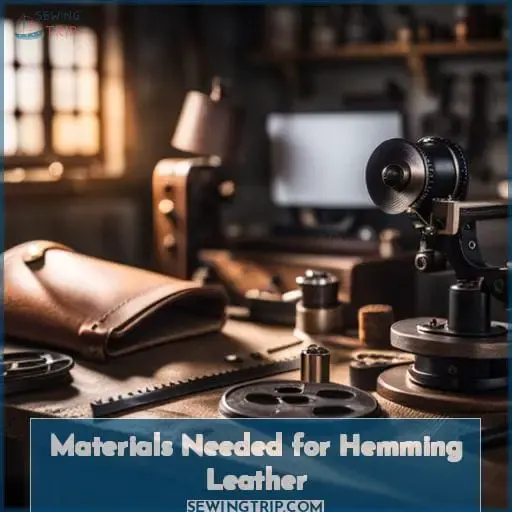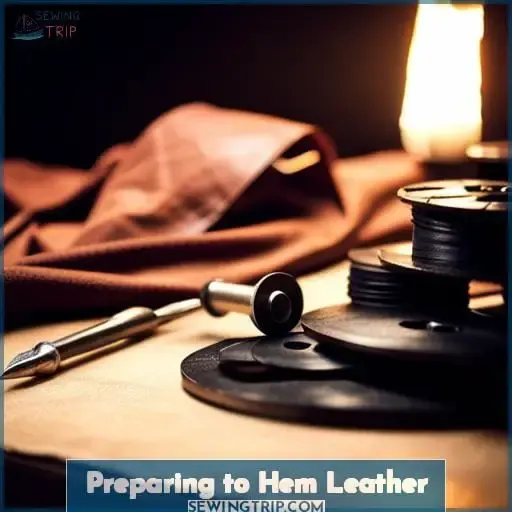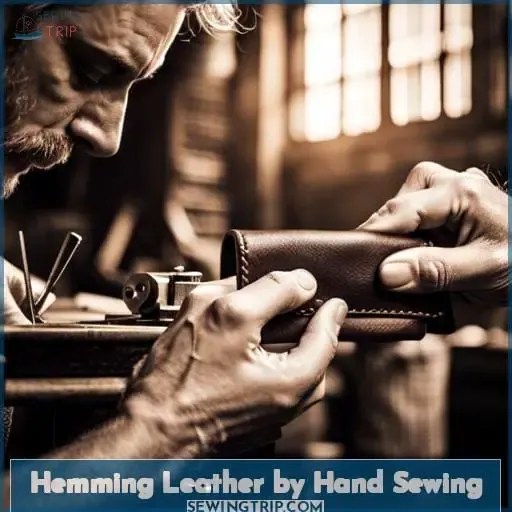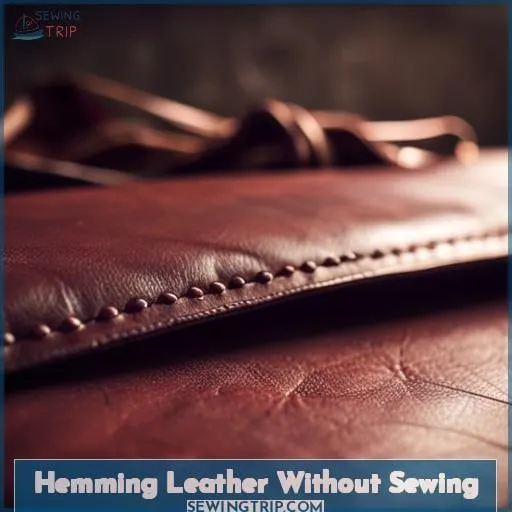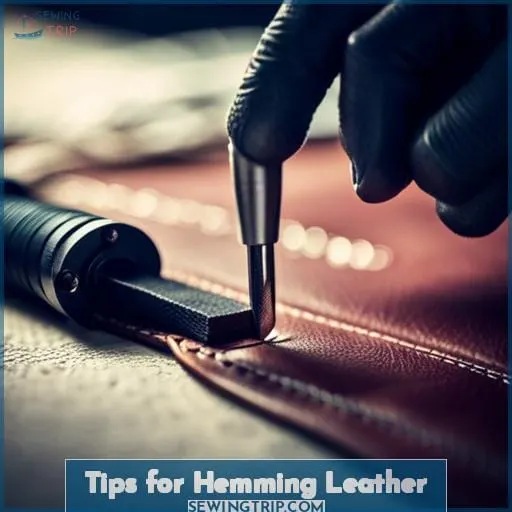This site is supported by our readers. We may earn a commission, at no cost to you, if you purchase through links.
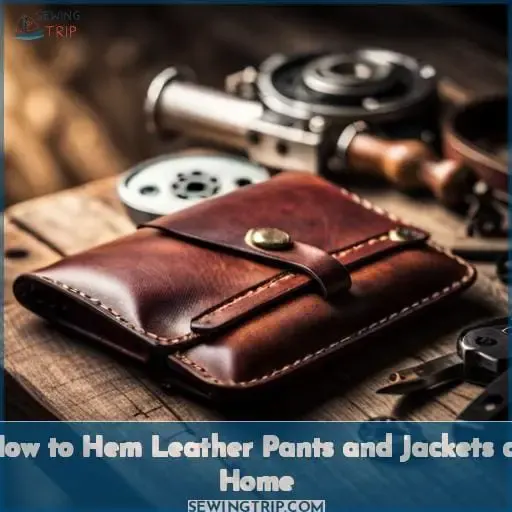 Fancy pair of leather pants you got there. Trouble is, they’re just a tad too long, leaving you looking like you’re waiting for a flood.
Fancy pair of leather pants you got there. Trouble is, they’re just a tad too long, leaving you looking like you’re waiting for a flood.
With a few simple tools and a steady hand, you can tailor those trousers to perfection right from the comfort of your own home.
Just grab a needle and get ready to get handsy with those pants. In just an hour or two, they’ll fit you like a glove.
Trust me, once you realize how simple this is, you’ll be hemming every leather item in your closet.
So kick off your too-long pants, grab that needle and let’s get hemming! Your perfectly fitted leather wardrobe awaits.
Table Of Contents
Key Takeaways
- Use essential tools such as basting tape, sewing clips, scissors, and a mallet.
- Hand sewing leather requires patience, precision, and consideration of stitching techniques.
- Consider using the saddle stitch technique for durability.
- No-sew methods like basting tape or leather adhesive can be effective with reinforcements when hemming leather.
Materials Needed for Hemming Leather
You’ll want some double-faced basting tape and sewing clips to temporarily hold the new hem in place before stitching.
Start by gathering leather-safe double-sided basting tape, sewing clips, scissors, and a mallet. The basting tape will hold the hem allowance down securely as you work. The clips, often made of plastic, replace pins which can damage leather.
You’ll also need sharp scissors to trim any excess hem allowance. A wooden or rubber mallet lets you flatten the hem without an iron.
Optionally, have on hand a special leather needle and heavy duty thread if you plan to finish the hem with topstitching.
With these basic leather hemming tools prepped and ready, you’ll be able to precisely tailor a leather garment’s length for a perfect fit.
Preparing to Hem Leather
After marking the desired length, turn the leather inside out to access and prepare the inner hem.
- Inspect the leather for any flaws or irregularities along the hem line. Smooth out any wrinkles.
- Use a leather mallet to flatten and compress the area below the fold line. This ensures a tidy, flat hem.
- If the hem allowance is thick, trim it with sharp scissors for a slimmer finish. Remove no more than 1/4 inch.
- Apply a strip of double-sided basting tape just below the fold line to hold the hem in place temporarily.
- For added reinforcement, fuse a strip of interfacing to the wrong side of the hem allowance using an iron on low heat.
Leather’s lack of fraying eliminates the need for zigzag or edge finishing stitches. With the hem prepped and ready, you can now move on to permanently securing the new length.
Hemming Leather by Hand Sewing
Seam ripper silently slicing stitched seams serves swiftly severing stubborn strands securing sleeves.
When hand sewing leather hems, start by carefully removing any existing stitches with a seam ripper. This allows you to customize the length precisely. Leather’s durable nature requires methodical hand sewing for stitching that’ll last.
Prepare the leather edging by skiving or lightly sanding the cut edge to flatten it. Use an awl to pre-punch evenly spaced holes. For thread, select a sturdy option like waxed linen or polyester. Aim for 10-12 stitches per inch. Employ a saddle stitch technique, weaving the needle in and out of the pre-punched holes.
For invisible hemming, try a blind stitch. Catch just a tiny bit of the garment fabric in each hole. Add seam sealant inside the hem for moisture protection. With care, hand sewing forms a clean, customized leather hem.
While hand sewing leather takes patience, you’re rewarded with a lasting hem with an artisanal finish. Avoid visible topstitching and create a subtle hem suited to the garment’s design. Seek an experienced alterationist for complex projects. For many leather pieces, hand sewing delivers precise stitching, neatly finished edges, and a personal custom touch.
| Hand Sewing Pros | Hand Sewing Cons |
|---|---|
| Invisible stitching | Time consuming |
| Custom fit | Requires skill/experience |
| Reinforced edges | Not removable |
| Durable, long-lasting | Thread holes remain |
Hemming Leather Without Sewing
When hemming leather without sewing, start by preparing basting tape or fabric glue. To avoid stitches, use double-sided basting tape to temporarily hold the hem in place or apply a leather adhesive inside the folded edge to permanently fix it.
Using Basting Tape
Sticking acrylic tape to the inside provides a quick fix before final stitching of your leather. Position it just below the fold line. Apply even pressure while smoothing out any bubbles underneath. Some tapes work on synthetics but leave residue on natural hides. Test first before hemming those vintage leathers.
For best results, reinforce the tape’s hold by adding a few hand stitches or dabs of flexible glue at stress points.
Tape won’t withstand repeated wear and washing like stitching does. But taping saves time and secures layers temporarily. Alternative methods take more effort. Tape easily holds pleats, facings, pockets – anything requiring precision alignment.
Using Glue
You’ll wanna grab that leather glue to get a strong bond when hemming your pants. Leather bonding glues offer a no sew finishing option when making adjustments. Alternatives like fabric fusion, shoe goo, barge cement, contact cement or rubber cement work too.
Just apply a thin layer along the leather’s edge, fold up your new hemline, smooth it down good, and let it cure fully.
Using quality leather adhesives lets you refashion garments like vegan leather pants into better fitting pieces without having to break out the needle and thread.
Hemming Leather Pants
When adjusting the length of your leather pants, first determine the desired shorter length and mark a guideline. Then apply fabric glue or rubber cement to create a new folded hem. You can reinforce the hem with hand-stitching for a clean, custom fit.
Shortening Pant Length
Mark where to snip for pants that fit perfectly. Determine the ideal placement based on your height and preferred shoe styles. For a tailored fit, measure your inseam barefoot while standing straight. Mark the inner seam allowance.
When ready, carefully cut along the marked line. For casual pants, add an extra inch or two. Test the length by cuffing first. This accounts for inaccuracy when eyeballing. Once you confirm the desired spot, create a stable guide line before cutting.
Pro tip: Use chalk or disappearing ink unless you want visible marks.
Achieve your ideal length through thoughtful measurement and neat cutting. Then style those stunners for a fashion win.
Finishing the New Hem
After folding the cuff to the desired length, secure the new hemline with a quick row of hand-stitching for a clean finish. This step is crucial in perfecting your leather hemming techniques, whether you’re altering Aritzia Melina Vegan Leather Pants or adjusting a stylish jacket.
The choice between glue and stitching is yours, but stitching provides a timeless and durable finish.
Consider these essential tips for finishing the new hem:
-
Sewing Leather Pants: Use heavy-duty thread and a sewing needle, ensuring your stitches are evenly spaced for strength.
-
Topstitching Leather: For faux leather, topstitching can add a professional touch. Use a mallet to keep the fabric flat while sewing.
-
Leather Cement: If you opt for glue, ensure it’s designed for leather. Follow the adhesive instructions carefully, and use a mallet to press the hem for a secure bond.
-
Trimming Hem Allowance: To achieve a neat appearance, trim any excess hem allowance for closer stitching.
Your choice between sewing and gluing depends on your preferences and the specific garment. Both methods can yield excellent results, allowing you to enjoy your perfectly hemmed leather pieces.
Hemming Leather Jackets
To ensure a well-fitting leather jacket, it’s essential to follow the steps for shortening the sleeves while maintaining the integrity of the lining.
First, mark the desired shortening length on the jacket sleeves.
Open the lining at the wrist area to access the sleeves.
Create a turn line where you’ll cut the leather to the desired length.
To prevent fraying, apply iron-on interfacing just above the hem.
Use leather glue or rubber cement to create a strip on the cut edge.
Fold the leather over the glue and smooth it down, ensuring a clean and secure edge.
Make sure the lining is the right length and includes a seam allowance.
Trim any excess lining material, and then hand-stitch the lining back in place.
This process works well not only for leather jackets but also for skirts and pants, allowing you to achieve a well-fitted, long-lasting jacket.
These jacket tailoring techniques are key for those looking to make precise clothing modifications without compromising the overall style and quality of their leather material.
So, whether it’s for style or a more comfortable fit, altering the sleeves of your leather jacket can be a game-changer in your outfit adjustment endeavors.
Tips for Hemming Leather
Crafting a well-structured outfit is like orchestrating a symphony; it requires precision and attention to detail. Using double-sided basting tape with the delicate balance of stickiness for temporary fabric placements is key when working with such an unyielding material.
Hemming leather, whether it’s a jacket, pants, or any other garment, demands finesse.
Here are four essential tips for tackling this challenging task:
-
Master Leather Sewing Techniques: Start by familiarizing yourself with leather sewing techniques. Leather doesn’t behave like traditional fabric, so you’ll need to adapt. Use clips or double-sided tape instead of pins to prevent visible holes. Finger-press or employ a mallet for precise seam allowances, ensuring your stitches hold securely.
-
Overcome Leather Hemming Challenges: Leather can be stubborn, making hemming a test of patience. Ensure your machine is equipped with a heavy-duty needle designed for leather. Adjust the tension and stitch length for optimal results. If you encounter skipped stitches or puckering, consider using a walking foot attachment for a smoother finish.
-
Leather Stitching Essentials: Quality matters. Invest in strong, heavy-duty thread that matches your leather’s color. To prevent fraying, edge containment isn’t necessary, but topstitching will give your project a polished look. Use a mallet for real leather and ensure your stitches are evenly spaced.
-
Fashion DIY and Cost to Hem Leather Pants: Hemming leather pants can be a cost-effective DIY project. However, if you’re unsure of your skills or lack the proper equipment, it’s wise to consult a professional. The cost to hem leather pants by a tailor can vary but ensures a perfect result.
Embarking on leather garment alterations can be rewarding, but success lies in mastering these leather hemming techniques. With practice and patience, you’ll create well-fitted, long-lasting leather pieces that add a touch of sophistication to your wardrobe.
Conclusion
To master the art of hemming leather, you’ve delved into the world of crafting, armed with invaluable knowledge and materials. As a skilled artisan, you’ve discovered the versatility of basting tape and the strength of leather glue.
With expert precision, you’ve tailored your leather pants and jackets, shortening hems and reinforcing seams. Through this journey, you’ve become a leather-hemming maestro. So, whether it’s a pair of pants or a stylish jacket, you can confidently and stylishly hem leather garments at home, turning your wardrobe into a canvas of personal fashion.

